WordPress zeigt für alle das gleiche Navigationsmenü an. Möglicherweise möchten Sie das Menü jedoch individuell anpassen, je nachdem, ob ein Benutzer angemeldet ist oder nicht.
Die Anzeige verschiedener Menüs für angemeldete Benutzer in WordPress ist eine großartige Möglichkeit, ein personalisiertes Erlebnis zu erstellen. So können Sie relevante Inhalte nur denjenigen anzeigen, die angemeldet sind, z. B. Kontodetails oder exklusive Ressourcen.
In dieser Anleitung wird erklärt, wie man mit 2 Methoden verschiedene Menüs für angemeldete Benutzer einrichten kann.
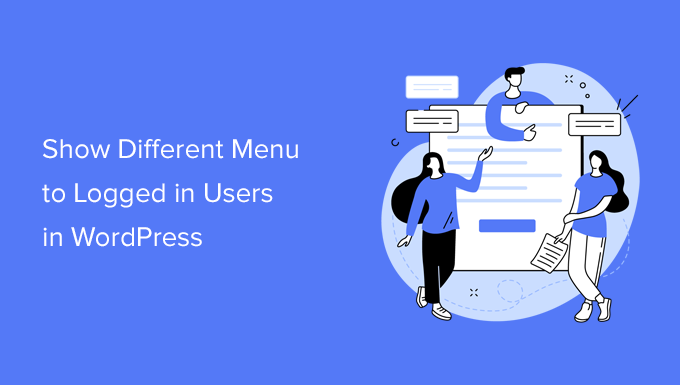
Warum werden angemeldeten Benutzern in WordPress unterschiedliche Menüs angezeigt?
Durch die Änderung verschiedener Bereiche Ihrer WordPress-Website auf der Grundlage Ihrer Besucher und deren Aktivitäten wird Ihre Website für jeden Benutzer individuell gestaltet.
Diese personalisierten Inhalte helfen Ihnen, die Benutzererfahrung auf Ihrer WordPress-Website zu verbessern.
Wenn Sie eine Website betreiben, auf der sich die Benutzer nicht registrieren oder anmelden müssen, können Sie wahrscheinlich auf Ihrer gesamten Website dieselben Navigationsmenüs verwenden. Für andere Websites kann es jedoch von großem Vorteil sein, angemeldeten Benutzern individuelle Menüs anzuzeigen.
Websites wie ein Online-Shop, eine Online-Lernplattform oder eine WordPress-Community können beispielsweise von personalisierten Navigationsmenüs profitieren.
Ein personalisiertes Navigationsmenü für angemeldete Benutzer hilft ihnen, die Dinge, für die sie sich angemeldet haben, leichter zu finden.
So kann beispielsweise ein Benutzer eines Online-Shops sein Konto verwalten, oder ein Mitglied einer kostenpflichtigen Community kann sein Abonnement problemlos verlängern oder die exklusiven Online-Kurse anzeigen, die es erworben hat.
Standardmäßig können Sie in WordPress so viele Navigationsmenüs erstellen, wie Sie möchten. Sie können jedoch nur ein Menü an einer bestimmten Position in Ihrem WordPress-Theme anzeigen lassen.
Bevor Sie Menüs für angemeldete Benutzer einrichten, müssen Sie zunächst zwei separate Navigationsmenüs erstellen. Ein Menü ist für angemeldete Benutzer, das andere für abgemeldete Benutzer gedacht. Fangen wir an.
Nur eine kurze Anmerkung! Die Methoden, die wir hier vorstellen, sind für Leute gedacht, die klassische WordPress Themes verwenden. Wenn Sie ein Block-Theme mit Funktionen zur vollständigen Website-Bearbeitung (FSE) ab WordPress 5.8 verwenden, funktioniert diese Methode möglicherweise nicht.
Erstellen von Menüs für angemeldete und nicht angemeldete Benutzer in WordPress
Um getrennte Menüs für die beiden Arten von Benutzern zu erstellen, müssen Sie im WordPress-Dashboard auf die Seite Design ” Menüs gehen.
Wenn Sie bereits ein Navigationsmenü haben, das Sie auf Ihrer Website für alle Benutzer verwenden, dann kann dies Ihr Standardmenü sein.
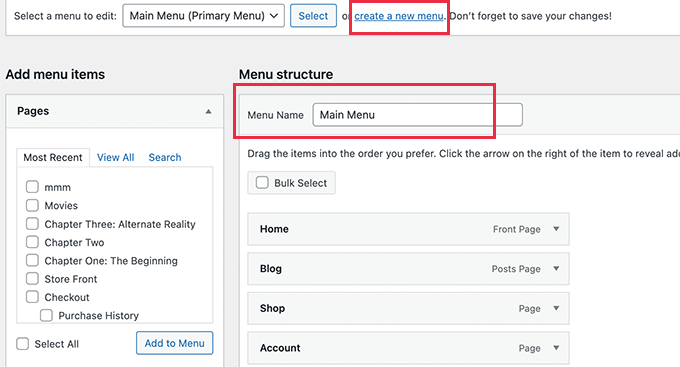
Danach können Sie auf den Link “Neues Menü erstellen” klicken, um ein neues individuelles Menü für Ihre angemeldeten Benutzer zu erstellen.
Fügen Sie hier Menüpunkte hinzu, die Sie registrierten oder angemeldeten Benutzern zeigen möchten. Sie könnten zum Beispiel einen Link zur Abmeldung in Ihr Menü aufnehmen.
Auf der linken Seite der Ansicht sehen Sie eine Liste der Seiten Ihrer Website. Markieren Sie einfach die Box neben der Seite, die Sie Ihrem Menü hinzufügen möchten, und klicken Sie auf den Button “Zum Menü hinzufügen”.
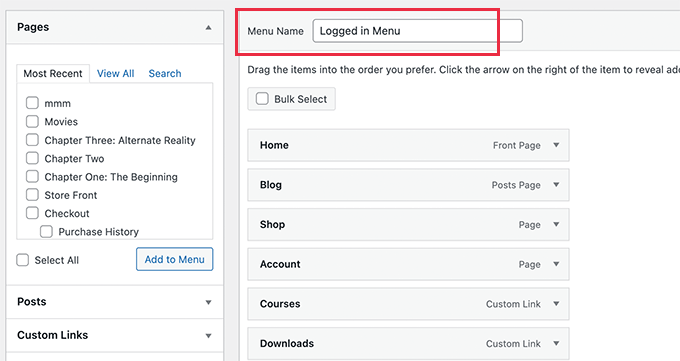
Sie können die Menüpunkte auch per Drag-and-drop auf der rechten Seite der Ansicht neu anordnen.
Weiter unten auf der Seite können Sie eine Position wählen, an der Ihr Menü angezeigt werden soll. Sie brauchen diesem Menü jetzt aber noch keine Position zuzuweisen. Das werden wir später in diesem Artikel tun.
Vergessen Sie nicht, auf den Button “Menü speichern” zu klicken, um Ihre Änderungen zu speichern.
Weitere Einzelheiten zum Erstellen von Menüs finden Sie in unserem Leitfaden für Einsteiger in die WordPress-Navigation.
Jetzt können Sie angemeldeten Benutzern verschiedene Menüs anzeigen. Hier ist ein kurzer Überblick über alle Methoden, die wir in diesem Leitfaden behandeln werden:
Schauen wir uns die erste Methode an.
Methode 1. Verschiedene Menüs für angemeldete Benutzer in WordPress mit einem Plugin anzeigen
Der einfachste Weg, angemeldeten Benutzern verschiedene Menüs anzuzeigen, ist die Verwendung des Plugins Conditional Menus. Installieren und aktivieren wir es also zuerst.
Weitere Einzelheiten finden Sie in unserer Schritt-für-Schritt-Anleitung für die Installation eines WordPress Plugins.
Nach der Aktivierung müssen Sie in Ihrem WordPress-Dashboard zu Design ” Menüs navigieren. Wechseln Sie dann zum Tab “Positionen verwalten”.
Hier sehen Sie die Liste der verfügbaren Positionen, die in Ihrem WordPress Theme definiert sind, und die Menüs, die derzeit angezeigt werden.
Zum Beispiel zeigt unsere Position “Primäres Menü” derzeit ein “Hauptmenü” an.
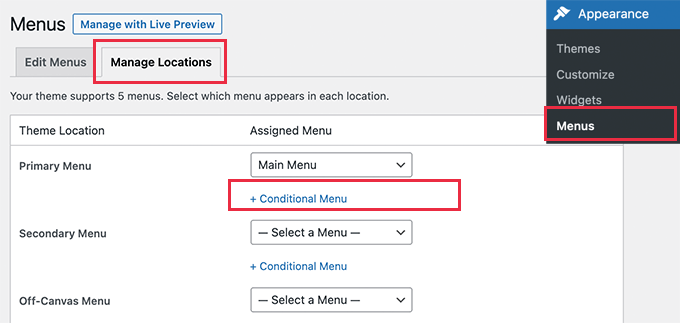
Jetzt müssen wir dem Plugin sagen, dass es ein anderes Menü anzeigen soll, wenn eine bestimmte Bedingung erfüllt ist.
Klicken Sie dazu auf den Link “+ Bedingtes Menü”. Dann können Sie das Navigationsmenü, das Sie den angemeldeten Benutzern zeigen möchten, aus dem Dropdown-Menü auswählen.

Als Nächstes müssen Sie auf den Link “+ Bedingungen” klicken.
Daraufhin erscheint ein Popup-Fenster, in dem Sie eine Reihe von Bedingungen zur Auswahl haben.
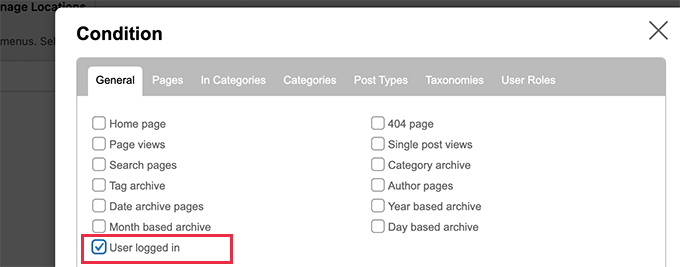
Aktivieren Sie einfach die Box neben der Option “Benutzer angemeldet” und klicken Sie dann auf den Button “Speichern”.
Sie können nun Ihre Website besuchen, um das Menü des angemeldeten Benutzers in Aktion zu sehen. Sie können sich auch von Ihrem WordPress-Admin abmelden, um das Navigationsmenü anzuzeigen, das allen anderen Benutzern angezeigt wird.
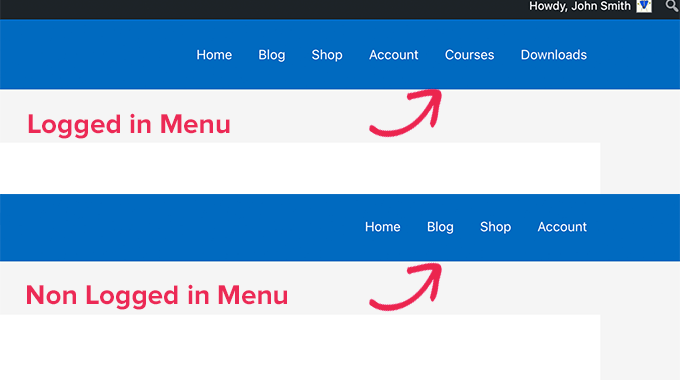
Methode 2. Manuelles Auswählen des angemeldeten Menüs in WordPress mit Code
Bei dieser Methode müssen Sie Code zu Ihrer WordPress-Website hinzufügen. Wenn Sie dies noch nicht getan haben, werfen Sie einen Blick auf unsere Anleitung zum Kopieren und Einfügen von Codeschnipseln in WordPress.
In der Regel müssen Sie einen Codeschnipsel in die Datei functions.php Ihres Themes oder in ein Website-spezifisches Plugin einfügen. Wir empfehlen diese Methode jedoch nicht, da sie möglicherweise Probleme mit Ihrer Website verursachen kann.
Stattdessen können Sie das WPCode Plugin verwenden.
MitWPCode können Sie individuelle Codeschnipsel zu Ihrer Website hinzufügen, ohne die Dateien des Themes direkt zu bearbeiten. Es hilft auch bei der Verwaltung dieser Snippets und stellt sicher, dass sie sicher ausgeführt werden, wodurch das Risiko, dass Ihre Website beschädigt wird, minimiert wird.
Um loszulegen, installieren wir das WPCode Plugin. Sie können die kostenlose Version von WPCode verwenden, da sie alles enthält, was Sie brauchen, um angemeldeten Benutzern verschiedene Menüs anzuzeigen.
Nach der Installation navigieren Sie zu Code Snippets “ + Snippets hinzufügen.
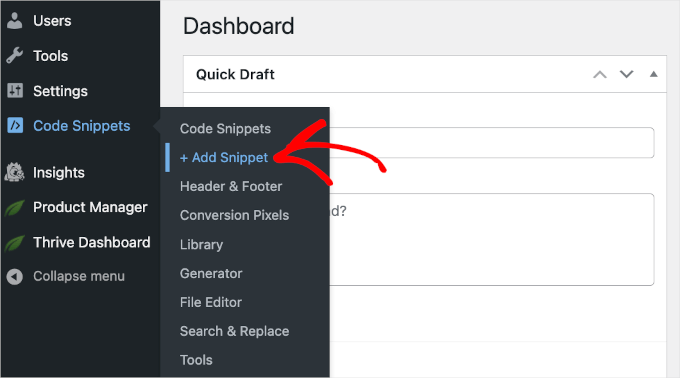
Dadurch wird die Galerie der WPCode-Codefragmente geöffnet.
Von hier aus können Sie auf den Button ‘+ Individuelles Snippet hinzufügen’ klicken.
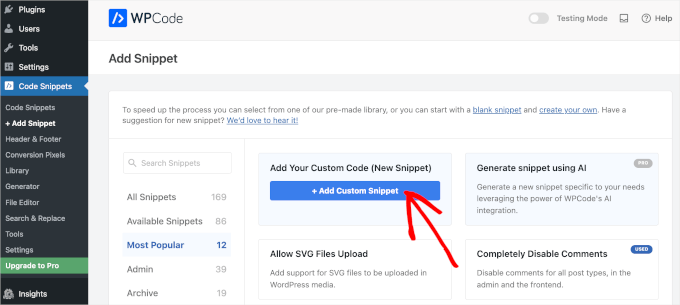
Sie gelangen dann zum Texteditor von WPCode.
Im nächsten Schritt fügen Sie Ihrem Code-Snippet einen Titel hinzu und wählen im Dropdown-Menü “Code-Typ” die Option “HTML-Snippet”.
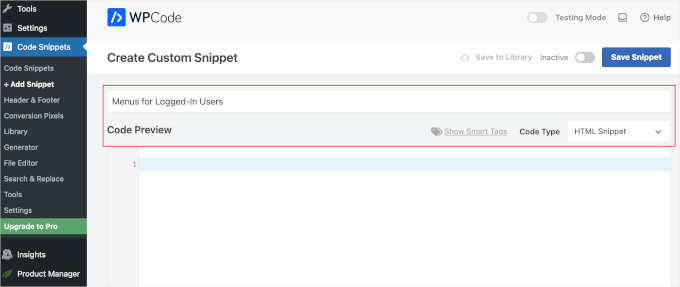
Kopieren Sie dann einfach den folgenden Code und fügen Sie ihn in das Feld “Codevorschau” ein:
1 2 3 4 5 6 7 8 9 10 11 12 | function my_wp_nav_menu_args( $args = '' ) {if( is_user_logged_in() ) {// Logged in menu to display$args['menu'] = 43;} else {// Non-logged-in menu to display$args['menu'] = 35;}return $args;}add_filter( 'wp_nav_menu_args', 'my_wp_nav_menu_args' ); |
So könnte es in Ihrem WPCode-Editor aussehen:
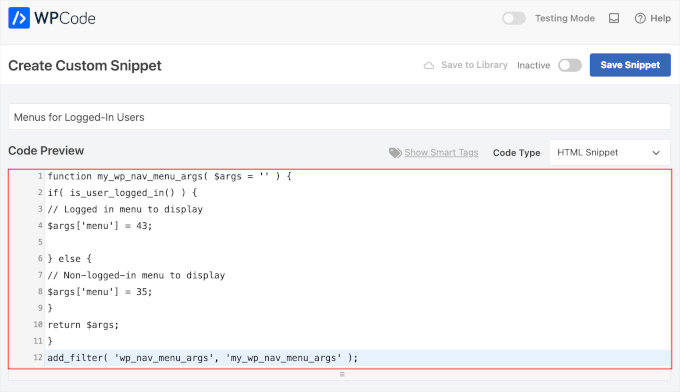
Stellen Sie sicher, dass Sie 43 und 35 durch die IDs für die Navigationsmenüs ersetzen, die Sie zuvor erstellt haben.
Sie finden die ID eines Navigationsmenüs, indem Sie es auf der Seite “Menüs” auswählen. Die ID-Nummer des Menüs wird in der Adressleiste Ihres Browsers angezeigt.
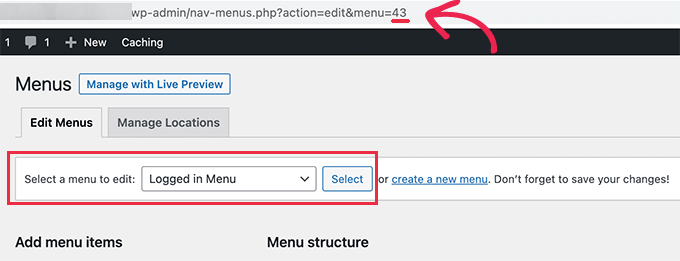
Sobald Sie sich vergewissert haben, dass alle Angaben korrekt sind, klicken Sie auf den blauen Button “Snippet speichern”.
Und das war’s! Wir hoffen, dieser Artikel hat Ihnen geholfen zu lernen, wie Sie angemeldeten Benutzern in WordPress ganz einfach verschiedene Navigationsmenüs anzeigen können. Als Nächstes möchten Sie vielleicht auch unsere Anleitung lesen, wie Sie Benutzern erlauben, ihre Freunde zur Registrierung in WordPress einzuladen, und wie Sie WordPress-Navigationsmenüs gestalten können.
Wenn Ihnen dieser Artikel gefallen hat, dann abonnieren Sie bitte unseren YouTube-Kanal für WordPress-Videotutorials. Sie können uns auch auf Twitter und Facebook finden.





Alex
Thanks for the code – works as it should, appreciated
WPBeginner Support
Glad our guide could be helpful!
Admin
Paul K
Great! But where do I find my theme’s function.php?
WPBeginner Support
It is in your theme’s folder, you can see more about it in our page below:
https://www.wpbeginner.com/glossary/functions-php/
Admin
Paul K
OK, found it, thanks. But I’m puzzled where to put the additional code. I’m not familiar with PHP but I see the “” at the end.
WPBeginner Support
For pasting code snippets, you want to take a look at our guide below that covers where to paste into your functions.php as well as where to past other code should you look at other code-based tutorials:
https://www.wpbeginner.com/beginners-guide/beginners-guide-to-pasting-snippets-from-the-web-into-wordpress/
Admin
Clara
Works great! I have the problem that I have to menus at the top: A headliner menu and the main menu. When I use the Code and the user is logged in bove menus switch to the logged-in menu. How can I adjust the code so that the headliner menu remains the same?
WPBeginner Support
For what you’re wanting, you would want to take a look at our article below:
https://www.wpbeginner.com/plugins/how-to-add-conditional-logic-to-menus-in-wordpress/
Admin
Sergio
Thank you very much!
WPBeginner Support
You’re welcome
Admin
Echo
Would be much easier if you could do it for a specific menu item rather than an entire menu. What would someone with 499 menu items have to do?
WPBeginner Support
We would not recommend that many menu items as that would be far too many for someone to navigate through which would likely cause an SEO issue if your menu links don’t add value for your visitors
Admin
Evaldo Santos
100%. Just configured it with Sahifa Theme and works like a charm.
Keep up with this good work.
Jason
Thank you!!
Bk Millanzi
this is so helpful, but is there a way to display a username and avatar which can act as a container of other profile menu items, as a drop-down menu?
Amarnadh
The path you showed is well and good only for just showing custom menus. But what if i want to show my content to a specific logged in user based on his interests. That is in detail, like various deals sites, when we login and save our interests, the next moment we see deals only on that specific topic. Can we make that possible using WordPress plugins.
Sam
Hey there, thanks for the great work. I have a question about multiple user roles.
So I have two main menus, Menu 1 and Menu 2.
I would like all users (logged in or out) to see the main menu unless they have the userole of “Alt”, in which case Menu 1 is replaced by Menu 2.
How would I go about doing that?
Tendai Mugoni
It is working, thanks
Curtis
@ERICLEE You can create a child theme to prevent that from happening. I just added this code and need to do the same thing.
shahzaib sarwer
can it possible to add the menus in the subscriber profile accept than the home page these menu pages not show on the home page, just on the every subscriber profile. if it possible then please guide me, and tell me how use any pluging for this.
shahzaib sarwer
can it possible to add the menus in profile of the subscriber in wp site , if it possible so please anyone guide me what i do and how use any pluging of this work.
Yuda
How can the same be achieeved on a multi-language members site? For example show different menu for users logged in in english and a different menu for users logged in with german?
WPBeginner Support
Hi Yuda,
If you are using a multilingual WordPress plugin then this should be handled by the plugin. You will essentially need to provide translations for your multilingual menus.
Admin
solomon
i have added log in menu and logout menu, how do i configure the page for login and log out ???,,
Jan-Paul Kleijn
First I thought of a plugin. Gotta quit thinking like that.
Then I saw your post and was sold.
Thank you for posting this, you helped me very nicely.
Phil
Thanks so much for that. Works perfectly.
Ariet
Hello,
This totally works!
But it change my footer menu too.. is there a way where my footer manu stay the same?
Tarron Acuff
So, I have 2 menus. One for the public and another that I would like employees to see when they are logged in. The employee menu would replace the main menu only when an employee is logged in.
Here is what I am currently using in my functions.php file
// Set the Role as a body class
function add_role_to_body( $classes ) {
$user = wp_get_current_user();
$user_roles = $user->roles;
foreach( $user_roles as $role ) {
$classes[] = ‘role-‘ . $role;
}
return $classes;
}
add_filter( ‘body_class’, ‘add_role_to_body’ );
***Here is what I added for CSS***
/* First hide the menu items for non “employee” user */
#top-menu li.menu-for-employee {
display: none;
}
/* Show the menu items for the “employee” user */
.role-employee #top-menu li.menu-for-employee {
display: initial;
}
When I log in as an employee both menus are showing.
Thanks in advance.
Wasim
its not working for me. It display default menu after I add this code, even my primary menu gone.
Joe
Hi Guys,
I nice tutorial but i was wondering could you use the same approach to replace a responsive menu at a certain screen size?
I have two menus but would rather have just one responsive menu at 768 px by replacing the menu with another.
Thanks
Pet
Awesome job with your guides. I am building my first wordpress site and I am finding your site incredibly helpful in guiding me along, thank you.
I really wanted to show different menus for logged in users (like ‘edit profile’) and for logged out users and that brought me here. The code you shared works alright for me. I now have two menus which are showing up nice. However, the last part of the code, add filter string, I believe, is messing me up a little bit. Now, another menu is showing under the sidebar widget. The ‘logged-in’ menu. I am using sydney theme and I have tried to no avail to remove this unnecessary menu. Any idea on how I can make it not display?
WPBeginner Support
Hi Pet,
Please check Appearance » Widgets page to see if you have a custom menu added as a widget there. If it is there then you can just delete that widget.
Admin
Pet
What genius! It worked! Thanks for the wonderful tip!!
Jomcy Johny
Me too have the same problem..Please help me..but I dont have widgets..Thank you..!
Alex Hammerschmied
Works like a charm…
Thanks for that.
Btw i love theses short tutorials
giovanna
Hi can you help me please? I have another trouble please? I need to hide one menu to all and allow only the vendors to see what I have to do please? what is the specific code i have to use please?
ericlee
When you modify the functions.php like so- wouldn’t it get wiped when you upgrade your WP next version ?
WPBeginner Support
Yes, it will get wiped out when you update your theme. To prevent this you can create a site-specific plugin.
Admin
Ramona
Will this work for a Buddypress install? Thanks.
Nikhil Chaudhari
the function set secoundary menu also? i only want to set primary menu. how to do that
Nikhil Chaudhari
this above function set secondary menu all i want to set only header menu?
how to do that
Asfaha
Hi,
thanks a lot for this solution, I’ve applied and woks perfect and saved me installing one more plugin.
Shafaq
this is the code for replacing existing menu to logged user menu by addming location top-menu and with menu loggedin no need else statement with this
add_filter( ‘wp_nav_menu_args’, function ( $args )
{
if( is_user_logged_in() && $args[‘theme_location’] === ‘top-menu’ ) {
$args[‘menu’] = ‘loggedin’;
}
return $args;
});
Ashraf Ali
———————————————————–
function my_wp_nav_menu_args( $args = ” ) {
if( is_user_logged_in() ) {
$args[‘menu’] = ‘logged-in’;
} else {
$args[‘menu’] = ‘logged-out’;
}
return $args;
}
add_filter( ‘wp_nav_menu_args’, ‘my_wp_nav_menu_args’ );
———————————————————–
Now how do i get it to work with
—————————————————
———————————————————————————————————————-
Please Advice
Iqbal Mahmud
If I want to hide a page from logged out user from a single menu what have to do?
Kasper
You can lock pages to hide them from logged out users. There are several plugins that make this very easy to do. Users Ultra comes to mind.
Zev
Everything worked perfectly.
However, I still have the issue of a repeated primary menu in the secondary navigation menu section which I can’t seem to remove (I don’t have a secondary menu set up).
Vince
I’m having the exact issue. The change reflects in the secondary menu location out of nowhere and I too don’t have a secondary menu setup. :/ Please advice how to deal with it.
Thanks in advance.
Chiranjeevi Vinodkumar
LISTEN!!!
Most of us, uses themes.
So first go to the functions.php of your theme.
Search with navigation as keyword.
In case of Shopkeeper theme..
==================================================================
register_nav_menus( array(
‘top-bar-navigation’ => __( ‘Top Bar Navigation’, ‘shopkeeper’ ),
‘main-navigation’ => __( ‘Main Navigation’, ‘shopkeeper’ ),
‘footer-navigation’ => __( ‘Footer Navigation’, ‘shopkeeper’ ),
===================================================================
This is how you look.. so pick the one which is primary, In my case, Its “Top Bar Navigation” hence used “top-bar-navigation”
I used the following code and worked like a charm!!!
This is my way of thanking the author.
Good day !!
Ann Novakowski
Here’s what worked for me with WP . I used this to create a specific primary menu for logged-in Buddypress users. It will NOT affect my footer menu OR social media menu for any visitors, so everyone sees the same secondary menus regardless of whether they’re logged in or not. This is based on all of the comments above (HT to Fransiska!).
Added the following to my Child Theme’s functions.php file:
// CHANGE MAIN MENU =ONLY= IF MEMBER IS LOGGED IN
function my_wp_nav_menu_args( $args = ” ) {
if ($args[‘theme_location’] == ‘primary’) {
if( is_user_logged_in()) {
$args[‘menu’] = ‘logged-in’;
}else{
$args[‘menu’] = ‘logged-out’;
}
}
return $args;
}
add_filter( ‘wp_nav_menu_args’, ‘my_wp_nav_menu_args’ );
Oliver
Don’t know what happened why my comment, but –> ” <– these are correct!
fidel toro
thanks!! help me a lot
Matthias Campbell
Hello,
I added this code (probably wrongly) in my functions.php within my theme in wordpress editor and now I have a constant 500 server error. Even after removing the code.
Before this i attempted to create a site specific plugin but that didnt work. Could you please tell me if the snippet requires an opening and closing bracket?
If so how do i do that?
My host cant help me now and they’re requesting I pay a programmer to help me for 50Eu per hour. Please help me. Its urgent.
I am still logged into wordpress but what ever I click I get the 500 error with this specific error.
PHP Parse error: syntax error, unexpected ‘}’ in line 1194.
This is because I pasted the snippet after all the text in the functions.php file.
I then removed the snippet to see if that would fix it, via editor and FTP and I still get the error.
I look forward to hearing your response.
Kind regards
WPBeginner Support
It depends on where you are adding the code. If there is a closing PHP tag before it then you need to add a php start tag like <?php
If this code is the last thing in the functions file then you don’t need to add a closing tag.
Admin
Hubert
If you have multiple menu locations and want to apply different menus for each location you can use the code bellow:
function my_wp_nav_menu_args( $args = ” ) {
// Primary menu location
if( ‘primary-main’ == $args[‘theme_location’] ) {
if( is_user_logged_in() ) {
$args[‘menu’] = ‘Primary-Logged-In’;
} else {
$args[‘menu’] = ‘Primary-Logged-Out’;
}
return $args;
}
// Secondary menu location
if( ‘secondary-menu’ == $args[‘theme_location’] ) {
if( is_user_logged_in() ) {
$args[‘menu’] = ‘Secondary-Logged-In’;
} else {
$args[‘menu’] = ‘Secondary-Logged-Out’;
}
return $args;
}
}
add_filter( ‘wp_nav_menu_args’, ‘my_wp_nav_menu_args’ );
Haji
This does not work, anyone that does know the proper code if you have 2 or more menus?
Ravikant
Perfect bro .Its work …. awesome work
Leopold
This was almost too easy!
Thanks alot for the simple article.
In this way I don’t have to install any plugin..
Gaurang
I think it is better to use IF MENU plugin. https://wordpress.org/plugins/if-menu/
Creating two separate menus like this, use has to create/update menu twice.
Chris
Hi Gaurang,
I’m curious to know why you feel using the plugin is better, than coding the functions.php file? I was told a while ago to watch how many plugins are actually used for a wordpress site, and the code above seems simple enough; minus the having to monitor every time your theme updates….
Thanks,
Rub
Great, how I can use it to show menu for logged user that have certain role?
Kit Johnson
This worked so simply and neatly. I didn’t think it would be this easy. Thank you!
Jason Sisson
this is awesome tried it. works. but i also would like to redirect by role
is that simple or much harder
Ryan R. Bayne
Thanks. Working with menu functions for the first time.
Creating the WTG Portal Manager plugin which will allow a portal to be defined very quickly. Every portal having it’s own menu. The plugin make the relationship between portal and menu clearer plus provide other unique options.
veer2412
how can i show different posts to different users??
veer2412
thnkx for the help.. but what if i want to show different users different posts on my site.. is there any way to do that using coding??
WPBeginner Staff
Under Appearance > Menus you need to choose a location for your menu. Seems like there are two areas on your site where you can add menus. So you need to create two different menus and then assign a location to them.
Heather Gile
what would the revised code for this be, if there was a distinction of ‘Primary’ and ‘Top’?
$args[‘primary-menu’] = ‘logged-in’;
$args[‘top-menu’] = ‘logged-in’;
else
$args[‘primary-menu’] = ‘logged-out’;
$args[‘top-menu’] = ‘logged-out’;
?
Kyle
WordPress will not let me put 2 menus in my “top header” location. The code you provided works, but it changed ALL of my menus to the logged in or out, and is not displaying my normal nav menu
b2995
I have a top menu as well as a site menu (under logo). How would I change the code to switch just that top menu. Right now, ALL my menus change.
Harry Slyman
You saved my day! thank you